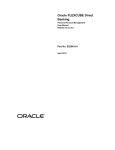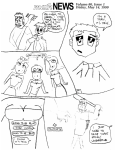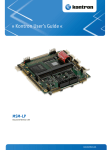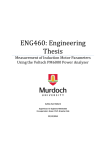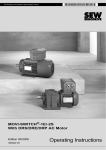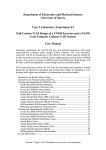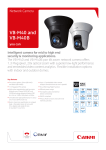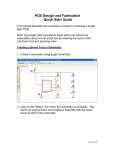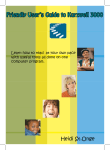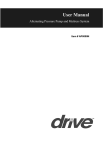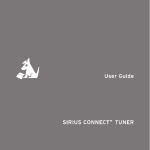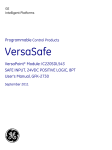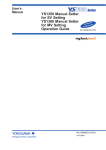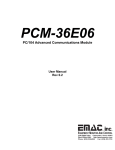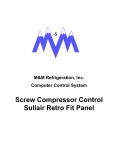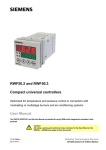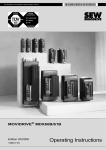Download ENSC 204—Assignment SCH1 - School of Engineering Science
Transcript
ENSC 204—Assignment SCH1 Introductory Logic Schematic from Netlists (Read this assignment carefully – before you begin) DUE Group Member List (by Email) CAD Schematic (General Office hand-in) 24 May 2002 Noon 11 June 2002 OBJECTIVES To explore simple generic ECAD netlists and learn how they relate to ECAD schematic symbol interconnection. To familiarize yourself with the selected ECAD software working environment, and to develop some basic skills in completing a simple logic schematic. Specific attention will be focused on using Nets, Busses, Net Labels, junctions, parts placement and arrangement, symbol orientation and annotations. Please organize yourselves into groups of 4 and elect a group leader. The leader will accurately gather the ID #, SFU registration First & Last Name, SFU Email address, and ENSC Year (1st, 2nd, 3rd or 4th) from each member. Then, on the ENSC204 web site, http://www.ensc.sfu.ca/people/faculty/dill/COURSES/ENSC204 follow the Group Registration link and complete the table. Do this before the specified due date. Your Group Number and member list will be posted here within a few days – please look for it. ASSIGNMENT TASK DISTRIBUTION & RESPONSIBILITIES A group-appointed leader will organize and divide the tasks and co-ordinate the group's efforts throughout this assignment. This person will become the primary representative between your group and the instructor(s) and will be responsible for ensuring that the assignment is complete and handed in on time. This is a role of responsibility, intended to develop interpersonal as well as time and task management skills that will prove a valuable learning experience for future engineering courses and the real world. Each group member must complete a fair and equal portion of every aspect of this assignment and should make an effort to develop skills in areas of non-familiarity in order to gain a comfortable understanding of the subject matter, concepts and tools used. In this case, try to work on weaknesses, not just strengths. * When students work in groups, there's always a tendency for those with strong skill sets in a particular area to do all the work for that portion of the assignment just to get it done as quickly as possible. This only serves to exclude the lesser-skilled partners and hinder their development. Please try not to let this happen in your group. 10/05/02 fred/204-02/ASGN-SCH1 2002R1.doc 1 IMPORTANT GENERAL COMMENTS FOR THIS ASSIGNMENT Lab Journal: Please note that although ENSC 204 is not designated as a 'Lab Course' per se, the activities you will be performing in this assignment are lab related. Therefore, all notes, calculations, sketches should be maintained in your lab journal. If you choose to work with loose pages, these should be maintained in a manner such that all project-group information remains together (a binder or similar). Be sure that all pages are appropriately organized and referenced with the date, author's name, group number, and topic/project title. Common Schedule & Learning Support: To ensure that all group members have an equal opportunity to perform and maintain continuity with all aspects of this assignment, your group should arrange a common time block, between 0830 and 1600 (Mon.-Fri.) when your group could meet at a prearranged location in LAB-1. In this way, the instructors supporting this assignment can be approached for assistance if needed. As instructors, we are sensitive the fact that you’ll be struggling with a lot of new and potentially challenging concepts and possibly quite foreign software. Obviously, we wish to see you sort out the bulk of the problems you encounter as best you can using the reference materials available (Lab Handbook, handouts, tutorial guides, and the wealth of stuff available on the Cadsoft website – www.cadsoftusa.com ). If you find that you are stuck or spending an unreasonable amount of time on any portion, please contact one of the instructors for guidance or advise them of your difficulty before due deadline. Current Revisions: Although you should try to accomplish most of the assignment stages together as a group (or sub-group), this may not always be possible. Agree on a file naming convention for each assignment and its revision levels for your work files. Use Email attachments to share your current revisions with the other members of your group. Never leave any work on lab computers – always back-up to floppy or ZIP drives. SOFTWARE REQUIRED - EAGLE355r3(3) by CadSoft Computer1 ITEMS SUPPLIED 1) Assignment SCH1 instructions 2) Assembled copies of the following files (included within SCH1 instructions) a) bus-sch1.net – ASCII netlist b) bus-sch1.pin - ASCII modified netlist (may be useful) c) bus-sch1part.txt - library part listing d) bus-sch1_net.scr - Eagle ASCII script file (a variation on the netlist) 1 EAGLE355 is installed on Engineering Science LabNet computers for your convenience. The EAGLE files are available for download from the ENSC 204 website for those wishing to use this software on their own PC. (You’ll need the ENSC document 'Getting Started with Cadsoft EAGLE355', filename EAGLESET.pdf). This assignment need not be accomplished in the lab, but you must use the EAGLE355 software. 10/05/02 fred/204-02/ASGN-SCH1 2002R1.doc 2 e) bus-sch1-block.sch - Eagle schematic block diagram 3) bus-sch1-parts.sch - Eagle schematic providing the unconnected parts 4) tutorial-eng.pdf - Eagle tutorial 5) MC74HC4351N.pdf - datasheet (if needed) * (2a-e) & (3 – reference only) are part of this document, (3 - 5) are separate files available on the ENSC204 Website. DETAILED INSTRUCTIONS * For private PC users - Before commencing, it is expected that you have downloaded or acquired the needed support files for EAGLE355R33 and have installed and configured EAGLE to suit the recommended preferences. (The steps for accomplishing this are given in the document 'Getting Started with Cadsoft EAGLE355', EAGLESET.pdf). 1) Print the working pages of this assignment (pgs 1-14). 2) Print optional items (4) & (5) as previously defined. 3) When steps 1 and 2 are completed, you're almost ready to begin. Start EAGLE. FILE⇒OPEN⇒SCHEMATIC⇒<bus-sch1-parts.sch> (part of the emailed file set – or from ENSC204 website). This drawing contains the frame/border and document field as well as an array of unconnected schematic symbols. Use FILE⇒SAVE_AS to save this file into your project target directory2, using the file naming format <(group# 2digits)+'SCH1'> eg '05SCH1'. So far so good??? Now for the tougher part... …to create a representative ECAD schematic from the given netlist. Using the printouts you've assembled, determine a reasonable starting arrangement for the parts on the screen. (You'll likely change and reorganize these a few times as the drawing takes shape). Examine the Netlist and draw NETs between the symbols. It's recommended that you carefully study the Netlist printout before getting too involved. Then try to attack the bulk stuff first by determining single parts that have multiple pin interconnections and connect them up using the NET and BUS commands. Cross off the nets on the printout as you complete them. An array of Power and Ground symbols are supplied on the drawing sheet for your convenience. If you have any extras after you've got everything neatly connected exactly in the way want them, you may delete them - try not to be too hasty - else you’ll be burning your valuable time hunting through all the libraries to find the replacements! 2 For personal PC users, work out of …EAGLE/Projects/204SCH1. For LabNet users work out of C:\temp, making certain to back this up regularly to your diskette in drive A:. 10/05/02 fred/204-02/ASGN-SCH1 2002R1.doc 3 (Source libraries are given in file BUS-SCH1PART.txt. Power symbols are in the FSupply.lbr. Deleted symbols can be reinserted using the ADD command. ***For this assignment, you shouldn’t need to add extra symbols to the drawing sheet***). General design rules to note: a) Connectors like HDR1 shall be placed with their pin orientation arranged in the same manner in which it would appear in the physical part or assembly – in this case, pin 1 = top left (as given). This is a standard practice to avoid confusion. b) Component pin swapping is not permitted in this exercise. You may find it somewhat beneficial to open the example schematics that come with EAGLE (look in your Eagle directory for subfolder 'Examples'). These illustrate how busses may be used. Don't study these too carefully, they're not perfect and still use some symbols which are flawed (these schematics haven't been altered since their creation in the early days of EAGLE) - the rest of 355R33 is just fine and has no bugs, errors or stability problems. Use the HELP option on EAGLE's top menu row to determine how to define busses. One of the objectives of this assignment is to use busses where applicable to simplify and clarify the path of related signals. Be sure to LABEL all signals and busses unless their function/name is clearly implied to the reader. To print EAGLE files: File⇒Print. Settings; scale factor ≥2, page limit=1, sheets=1/1, rotate, black, solid. **** Always save & make backups – frequently! **** WHAT TO HAND IN *** In a reusable, sealable folder of your choice bearing your group # boldly in front 1) A printout of your finished ECAD schematic (in landscape format). 2) A 1.44MB diskette a) containing your final schematic file only in a directory folder named 204SCH1. Be sure to use the file naming format <group# (2digits)+'SCH1'> eg '05SCH1'. b) containing a folder named MEMBERS. With a text editor (ASCII format) create a file containing the group number and the names, student numbers and email addresses of your group members. c) with its contents verified to be virus free!!!! d) labeled with your group number and ‘ENSC 204 Summer 2002’. Resubmissions: If you are requested to correct aspects of your work for resubmission, save your file into the appropriate folder on your diskette and name the file – <Group # (2 digits)>+<SCH1>+<R>+<revision #> eg. 05SCH1R2. Keep your original file(s) intact, making no further changes to it. 10/05/02 fred/204-02/ASGN-SCH1 2002R1.doc 4 OPTIONAL PWB EXTRA (FOR KEENERS – NO EXTRA MARKS) This’ll only take a few minutes and it’s fun. It’ll also give you a better insight into the power of linked annotation and why schematic entry accuracy is of paramount importance. Once you’ve created your schematic in EAGLE and are confident that all is properly done, type the command board on EAGLE’s Schematic Editor window command line and hit ↵ (enter). This should open a new window showing a rectangular board outline as well as a bunch of PWB parts footprints connected by a ratsnest of airwires. Try moving the parts around and arranging them inside the board outline area keeping in mind that the maximum PWB dimensions are restricted to 100x80mm (4"x3.2"). Keep the part’s pads aligned on the 100mil grid points. Using the Route command with the default track width setting of 16, try manually routing a few of the connections point-point on the bottom layer. Next, start routing one track on the bottom layer to a desired transition point, click left mouse button, change the layer to Top and finish the connection. Observe the automatic insertion of a via at the layer transition point. Now, on the command line type Ripup and hit ↵ (enter). Ripup all. You should be back to all airwires. On the command line, type Auto and hit ↵ (enter). An Autorouter set-up screen will appear. Using the default settings, select Start and see what happens. Ripup the works again and try tinkering with the autorouter option settings especially in the Layer section Top and Bottom direction setting boxes. You can also play with the Minimum Distance and Track settings and see what happens. Don’t play with the other settings; some can foul things up pretty quickly – refer to the EAGLE user manual for details on these settings. Please observe that the board design is directly linked to the schematic, with the schematic being the master. Try deleting a component, airwire or track that you’ve routed on the board and see what happens. This annotation link is an extremely useful tool. Please always remember, however, that once a board job has been started, both the schematic and the board must always be open at the same time during an editing session. EAGLE will warn you if are about to do something which may disrupt the link. If you open only one (either the schematic or board) and make critical edits to it, when the other is opened later the two will likely be out of sync and it’ll take some serious tinkering to get them communicating again. Good Luck!!! 10/05/02 fred/204-02/ASGN-SCH1 2002R1.doc 5 EAGLE Version 3.55r33 Copyright (c) 1988-1999 CadSoft Netlist a:bus-sch1.net exported from Bus-sch1.sch at 22/03/2001 11:12:00a Net Part Pad Pin Sheet +5V C1 C3 HDR1 HDR1 RN1 U2 + 2 17 23 1 20 1 2 17 23 C VCC 1 1 1 1 1 1 -5V C2 C4 HDR1 U2 2 26 9 2 2 26 VEE 1 1 1 1 CSA HDR1 RN1 U2 18 5 15 18 4 A 1 1 1 CSB HDR1 RN1 U2 19 4 13 19 3 B 1 1 1 CSC HDR1 RN1 U2 20 3 12 20 2 C 1 1 1 EN1 HDR1 U2 21 7 21 SE1 1 1 EN2 HDR1 U2 22 8 22 SE2 1 1 GNDA HDR1 HDR1 HDR1 HDR1 HDR1 HDR1 HDR1 HDR1 HDR2 10 12 14 16 2 4 6 8 2 10 12 14 16 2 4 6 8 1 1 1 1 1 1 1 1 1 1 GNDD C1 C2 C3 C4 HDR1 HDR1 U2 + 1 1 24 25 10 2 1 1 1 24 25 GND 1 1 1 1 1 1 1 10/05/02 fred/204-02/ASGN-SCH1 2002R1.doc 6 I/O HDR2 R1 1 1 2 1 1 1 LE RN1 U2 2 11 1 LE 1 1 X R1 U2 2 4 2 X 1 1 X0 HDR1 U2 1 17 1 X0 1 1 X1 HDR1 U2 3 18 3 X1 1 1 X2 HDR1 U2 5 19 5 X2 1 1 X3 HDR1 U2 7 16 7 X3 1 1 X4 HDR1 U2 9 1 9 X4 1 1 X5 HDR1 U2 11 6 11 X5 1 1 X6 HDR1 U2 13 2 13 X6 1 1 X7 HDR1 U2 15 5 15 X7 1 1 10/05/02 fred/204-02/ASGN-SCH1 2002R1.doc 7 EAGLE Version 3.55r33 Copyright (c) 1988-1999 CadSoft Pinlist c:\program files\EAGLE355win\projects\204\bus-sch1.pin exported from Bus-sch1.sch at 13/07/2001 10:38:59 Part Pad Pin C1 + - 1 2 Pas Pas +5V GNDD C2 + - 1 2 Pas Pas GNDD -5V C3 1 2 1 2 Pas Pas GNDD +5V C4 1 2 1 2 Pas Pas GNDD -5V HDR1 1 2 3 4 5 6 7 8 9 10 11 12 13 14 15 16 17 18 19 20 21 22 23 24 25 26 1 2 3 4 5 6 7 8 9 10 11 12 13 14 15 16 17 18 19 20 21 22 23 24 25 26 Pas Pas Pas Pas Pas Pas Pas Pas Pas Pas Pas Pas Pas Pas Pas Pas Pas Pas Pas Pas Pas Pas Pas Pas Pas Pas X0 GNDA X1 GNDA X2 GNDA X3 GNDA X4 GNDA X5 GNDA X6 GNDA X7 GNDA +5V CSA CSB CSC EN1 EN2 +5V GNDD GNDD -5V HDR2 1 2 2 1 Pas Pas I/O GNDA R1 1 2 1 2 Pas Pas I/O X RN1 1 2 3 C 1 2 Pas Pas Pas +5V LE CSC 10/05/02 Dir Net fred/204-02/ASGN-SCH1 2002R1.doc 8 U2 10/05/02 4 5 3 4 Pas Pas CSB CSA 1 2 4 5 6 7 8 9 10 11 12 13 15 16 17 18 19 20 X4 X6 X X7 X5 SE1 SE2 VEE GND LE C B A X3 X0 X1 X2 VCC Pas Pas Pas Pas Pas In In Pwr Pwr In In In In Pas Pas Pas Pas Pwr X4 X6 X X7 X5 EN1 EN2 -5V GNDD LE CSC CSB CSA X3 X0 X1 X2 +5V fred/204-02/ASGN-SCH1 2002R1.doc 9 EAGLE Version 3.55r33 Copyright (c) 1988-1999 CadSoft Partlist a:bus-sch1part.txt exported from Bus-sch1.sch at 22/03/2001 10:59:30a Part Value Device Package Library Sheet C1 C2 C3 C4 HDR1 HDR2 R1 RN1 U2 10u/T 10u/T 100n 100n BXHDR26 MTA100SL02 1K00 10K 74HC4351N CAPP-RBTA1 CAPP-RBTA1 CAPNP-CK05 CAPNP-CK05 BXHDR26 MTA100SL02 RESUS-10 RSIPB04P 74HC4351N C100RBTA C100RBTA CK05 CK05 BXHD26 PH1X02SL R-10 RSIP05 DIL-20 FDEVICE FDEVICE FDEVICE FDEVICE FCONNECT FCONNECT FDEVICE RESNETWK F74XX 1 1 1 1 1 1 1 1 1 10/05/02 fred/204-02/ASGN-SCH1 2002R1.doc 10 EAGLE Version 3.55r33 Copyright (c) 1988-1999 CadSoft Netscript a:bus-sch1netscr.scr exported from Bus-sch1.sch at 22/03/2001 11:10a Signal '+5V' 'C1' '+' \ 'C3' '2' \ 'HDR1' '17' \ 'HDR1' '23' \ 'RN1' '1' \ 'U2' '20' \ ; Signal '-5V' 'C2' '-' \ 'C4' '2' \ 'HDR1' '26' \ 'U2' '9' \ ; Signal 'CSA' 'HDR1' '18' \ 'RN1' '5' \ 'U2' '15' \ ; Signal 'CSB' 'HDR1' '19' \ 'RN1' '4' \ 'U2' '13' \ ; Signal 'CSC' 'HDR1' '20' \ 'RN1' '3' \ 'U2' '12' \ ; Signal 'EN1' 'HDR1' '21' \ 'U2' '7' \ ; Signal 'EN2' 'HDR1' '22' \ 'U2' '8' \ ; Signal 'GNDA' 'HDR1' '10' \ 'HDR1' '12' \ 'HDR1' '14' \ 'HDR1' '16' \ 'HDR1' '2' \ 'HDR1' '4' \ 'HDR1' '6' \ 'HDR1' '8' \ 'HDR2' '2' \ ; Signal 'GNDD' 'C1' '-' \ 'C2' '+' \ 'C3' '1' \ 'C4' '1' \ 'HDR1' '24' \ 'HDR1' '25' \ 'U2' '10' \ ; Signal 'I/O' 'HDR2' '1' \ 'R1' '1' \ ; 10/05/02 fred/204-02/ASGN-SCH1 2002R1.doc 11 Signal 'LE' Signal 'X' Signal 'X0' Signal 'X1' Signal 'X2' Signal 'X3' Signal 'X4' Signal 'X5' Signal 'X6' Signal 'X7' 10/05/02 'RN1' 'U2' ; 'R1' 'U2' ; 'HDR1' 'U2' ; 'HDR1' 'U2' ; 'HDR1' 'U2' ; 'HDR1' 'U2' ; 'HDR1' 'U2' ; 'HDR1' 'U2' ; 'HDR1' 'U2' ; 'HDR1' 'U2' ; '2' \ '11' \ '2' \ '4' \ '1' \ '17' \ '3' \ '18' \ '5' \ '19' \ '7' \ '16' \ '9' \ '1' \ '11' \ '6' \ '13' \ '2' \ '15' \ '5' \ fred/204-02/ASGN-SCH1 2002R1.doc 12 13/05/02 fred/204-02/ASGN-SCH1 2002.doc 13 13/05/02 fred/204-02/ASGN-SCH1 2002.doc 14














